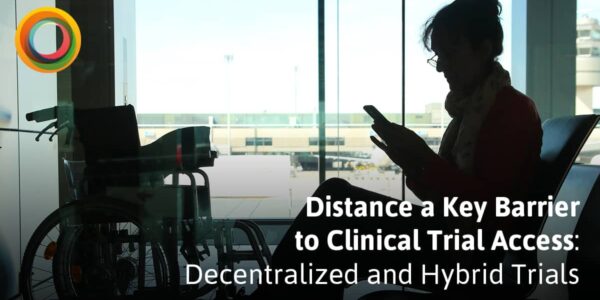
Before we begin exploring the efficacy and relevance of DCTs, let’s first agree on their definition and what the mdgroup team means when discussing Decentralised Clinical Trials.
A key component of most definitions of DCTs – also termed “direct-to-participant trials” or “virtual clinical trials” – is that they allow visits/procedures to be done away from a traditional clinical research site. They are often characterised by their adoption and leverage of “virtual” tools and technologies and the growing role of the patient in the administration of their own care.
Telemedicine, sensory-based technologies, wearable medical devices, home visits, patient-driven virtual healthcare interfaces, and direct delivery of study drugs and materials to patients’ homes are all components of a DCT in progress.
In a fully decentralised clinical trial, not only is medicine administered in the patient’s home, workplace, hotel room, local pharmacy, or even local doctor, but all patient recruitment, study equipment provision, and data gathering are done remotely or virtually between the study team and the patient.
But Do Decentralised Clinical Trials Really Improve Clinical Outcomes?
In other words, can we prove that DCTs live up to the hype?
First, a bit of a fact check: DCTs are not that ‘new’.
The first entirely virtual clinical trial, under an Investigational New Drug application, was carried out by Pfizer in 2011 in their REMOTE (Research on Electronic Monitoring of Overactive Bladder Treatment Experience) trial.
During REMOTE, no in-person site visits occurred, and the study investigators used internet recruitment, online questionnaires, electronic diaries, and direct-to-patient delivery of the investigational drug.
Since the U.S. Congress passed the 21st Century Cures Act in 2016, the FDA has been charged with developing a framework and guidance for novel trial designs and using evidence from sources other than traditional clinical trials to support drug approval.
Then came the global pandemic, which forced the industry to adapt at an unprecedented rate. As a result, active decentralised trials jumped 40% in 2020 from 912 to 1,293.
With organisations such as The Decentralised Trials & Research Alliance (DTRA) empowering and supporting the uptake of this research methodology across the industry, decentralised clinical trials are here to stay.
In this article, we’ll explore the role of DCTs and their impact on patient-centricity. We’ll also look at innovative ways to create more remarkable patient experiences at every touch point, leading to drastically improved clinical outcomes.
Our complete guide to decentralised clinical trials explores the following:
- What is the impact of Decentralised Clinical Trials on patients?
- What are the impacts of Decentralised Clinical Trials on clinical outcomes?
- What new challenges are posed by Decentralised Clinical Trials?
- What is the future of Decentralised Clinical Trials?
- The future is Patient-centric Hybrid Trials (PHTs).
What is the Impact of Decentralised Clinical Trials on patients?
The patient is always the most important factor in any clinical trial.
At mdgroup, we believe in true patient-centricity. For us, this means putting the patient, their needs, and what excellent care looks and feels like at the heart of any clinical trial.
Why? Because better attention to the patient’s well-being makes for better trial outcomes – which, in turn, leads to better care and health equity across the board.
We’re proud to have facilitated several complex global studies where DCT techniques have delivered remarkable outcomes.
From organising mobile nurse visits to remote parts of the Australian Outback, setting up dedicated pseudo-clinical spaces in hotel suites, and carrying out peripheral blood mononuclear cell (PBMC) extraction, our team provides complete, at-home care services that significantly improve access to clinical trials.
We know first-hand how taking care of the patient can have a hugely positive impact.
What patients value most about DCTs is being listened to.
DCTs offer patients the reassurance, flexibility, comfort, control, and ownership over their care that traditional trials sometimes cannot.
Bigger picture, listening to a patient’s needs, meeting them where they are, and including them in the trial design increases their engagement and, ultimately, retention.
Indeed, in our experience, there have been several trials that could only take place off-site. We have provided specialist nursing care and home health visits to ensure a seamless continuation of research care outside of a primary study site during the pandemic.
Read more about the impact of DCTs on patients in our case studies.
Find out about our mobile nursing recruitment agency – seacolehealth
What is the Impact of DCTs on clinical outcomes?
Patient retention and engagement have long been challenges in clinical research, and patient drop-outs can cost sponsors millions in lost revenue. DCTs go some way to providing a solution.
Better Geographical Reach
In some cases, only 5% of eligible patients participate in clinical research. One of the factors contributing to that low number is geography and the inability of patients to travel to a trial site.
Virtual trials remove geographical barriers, making trial participation more accessible to patients worldwide.
Opening studies up this way increases and optimises the patient pool and reduces the need to over-enrol based on anticipated attrition or drop-out rates to improve cost efficiency.
But don’t just take our word for it; pharmaceutical leaders at McKinsey’s December 2020 Clinical Operations Roundtable agreed that trial adaptations [of DCTs] during the pandemic were positive and helped better address patient needs.
Prefer to read this later? Download the whitepaper PDF instead: here
Increasing Diversity in Clinical Trials
We can also ensure diversity in clinical trials by using DCT methodology to reach under-represented groups.
Historic under-representation of racial and ethnic minorities in clinical research is one of the most significant contributing factors to health inequality.
We’re passionate supporters of any methodologies that move us towards a more equitable healthcare system.
As medical technology advances, we have a greater opportunity than ever to address barriers to clinical trial awareness, enrolment, engagement, and retention.
Read more about our commitment to diversity in clinical trials
Listen to how redefining clinical trials can improve health equity.
What Are The New Challenges Posed by DCTs?
As with the change and adoption of any new methodologies and technologies, there are potential challenges and risks we need to be aware of.
Making sure we move forward carefully is of the utmost importance when considering patient care.
So, what challenges can we already see emerging?
Digital education & expectations
There is a general assumption that the mainstream digital consumer has a basic experience with online behaviour and handheld devices. However, digital competency and expectations vary, and not everyone has access to technology.
Moreover, we can’t second guess how our patients use and work with technology day-to-day.
At the other end of the digital scale, other patients will be very familiar with conducting their lives online. With the widespread adoption of online shopping, chat functions, and social media, there are already expectations from the digital native of how intuitive, simple, easy, and accessible any digital interface ‘should’ be.
We also have to interrogate how well the MedTech we’re introducing to our patients interacts with other devices. Are we adding a layer of complication to the lives of a patient that will increase their stress levels? How can we make this the simplest ‘bolt-on’ possible? It’s crucial we ensure the digital interactions we require of our patients are as slick and as easy as possible.
Device Hardware Ownership & Internet Poverty:
This is a huge consideration if we are committed to global health equity.
Even though 5.11 billion people – 65.6% of the global population – use the internet, the rest of humanity, the “digitally dispossessed”, find that even when it’s possible, access to the internet is unstable and often prohibitively expensive.
Aside from mitigating against any behavioural assumptions, daily access to the internet and a smartphone is not a level playing field. Ensuring diversity in DCTs and true health equity means considering how everyone can access a DCT.
Ethics and data privacy:
The US digital health market was valued at $77 billion in 2022 and is on course for 17% annual growth between 2023 – 2030.
Alongside the leaps and bounds in improvements to patient care, this market buoyancy will inevitably lead to occasional fallout and learnings where the hugely regulated healthcare industry meets cutting-edge digital developers.
Threats to cyber security are one of the biggest challenges health innovators have faced in recent years. So tech innovators in the clinical space need exceptional governance and clinical safety “baked into” the heart of what they do. No matter how fast-moving health innovations are, patient safety must always be the highest priority.
Drug distribution and management
With DCTs, medication is often shipped to the patient’s home, which presents many challenges of its own. These challenges can include:
- An increase in costs
- Potential inconsistency with its storage and stability
- Potential of unauthorised access
- Potential for interruptions to the study should the refill not be received on time
- Increased risk of tampering
- Inconsistent administration of the drug
- Risk of incorrect dosing and over-burdening of the patient and/or caregiver, if they are storing IMP and learning how to administer the medicines
Losing the human touch:
Technology is vital for the future of clinical trials, but it’s not a ‘one size fits all’ solution.
The Center for Information and Study on Clinical Research Participation (CISCRP) survey showed that many patients found features like questionnaires, text messages, and video calls helpful during their trials. However, a third of patients surveyed said using technology, such as smartphones or tablets, disrupted their day.
This demonstrates the importance of finding the right balance and ensuring technologies are deployed appropriately and in conjunction with other patient-related services. For example, giving patients a link to an app and saying you’ll speak to them in four weeks will not keep them engaged. There must be an ongoing dialogue to establish a meaningful relationship.
Read more about the challenges posed by DCTs in our review of the SCOPE conference: Decentralised Trials, Technology & Patient Engagement.
Listen to our podcast on how we can tackle the biggest challenges of MedTech
So, what is the Future of the DCT?
We believe that’s the wrong question.
We believe a better question is: What is the Future of the Clinical Trial?
Our answer will always be patient-centricity.
Listening to the voice of the Patient
Patients who feel comfortable, confident, and included in their care have a dramatically improved trial experience, leading to better engagement, retention, and clinical outcomes. We’re proud to have been putting patients first in clinical research for over 20 years; our results demonstrate the positive impact this has at every stage of the clinical journey.
The future is Patient-centric Hybrid Trials
Decentralisation for the sake of decentralisation is not patient-centric.
Some patients may have limited access to technology or the internet, have a condition that means they must go to the study site, or simply cannot undertake visits in their homes.
We must listen to the patient’s voice and respond accordingly, designing the trial protocol to suit individual patients’ needs.
Whether we are taking the patient to the trial, or the trial to the patient, the days of a ‘one size fits all’ approach to clinical trials are over.
Patient-centric Hybrid Trials (PHTs) are more accessible, can reach broader patient populations, and work for a more diverse range of people. This leads to better health equity.
DCTs are an essential step forward, but they are not the answer. The Patient-centric Hybrid Trial is the future.
Want to save this content to share with colleagues? Download the whitepaper PDF: here



